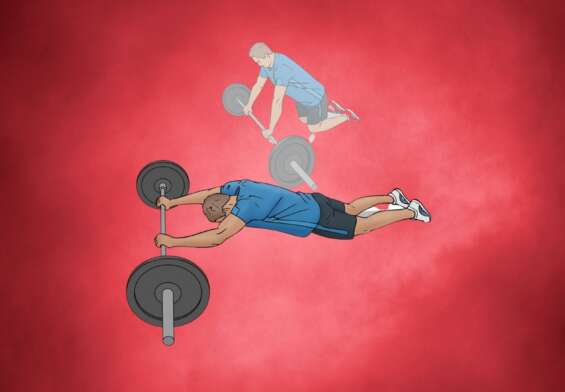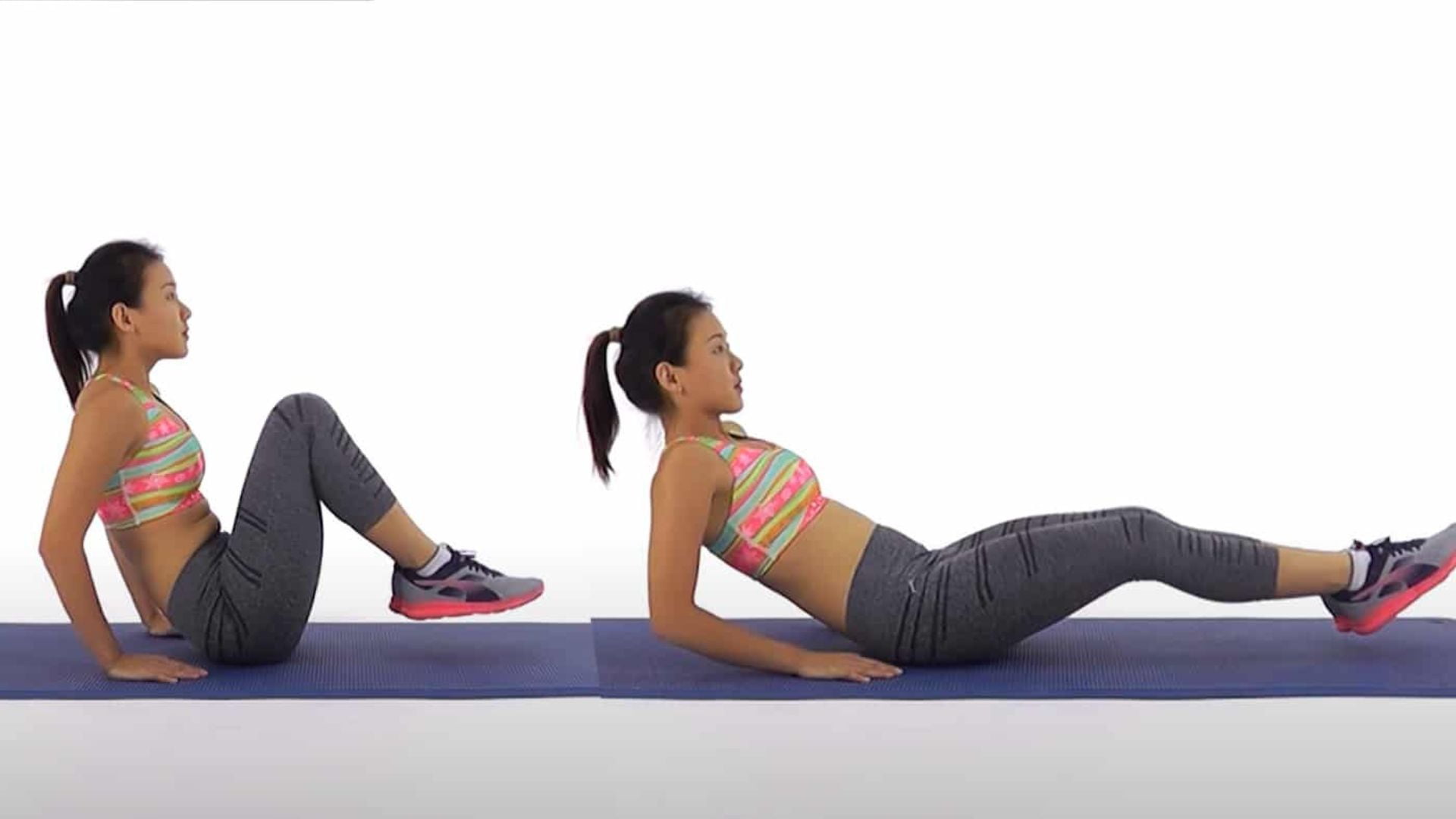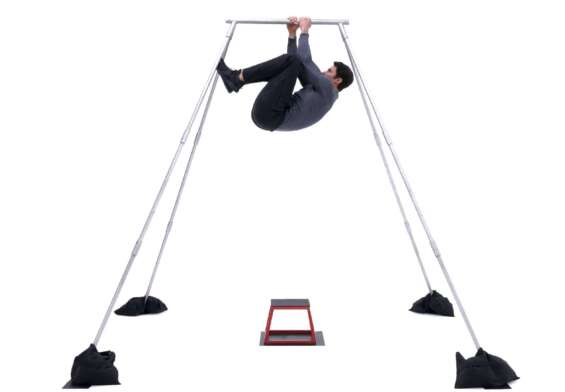
Banded Crunch (Strengthen Your Core) Detailed Exercise Guide
Are you looking to get stronger abs? Look no further than Banded Crunch! This exercise is a great movement that targets your abs muscles, improving your core strength and stability. Here at FitGAG, we’ve put together an expert guide to help you get the most out of your Banded Crunch. Get ready to get stronger abs!
Exercise Information
The Banded Crunch is a resistance training exercise that targets the muscles in the abs and obliques. This exercise involves using a resistance band to add resistance throughout the entire range of motion, increasing muscle activation in the targeted muscle groups. Let’s dive into some general information about this exercise:
Level
The Banded Crunch is a beginner-level exercise that is suitable for individuals of all fitness levels.
Equipment
To perform the Banded Crunch, you will need a resistance band.
Type of Exercise
The Banded Crunch is an isolation exercise that targets a single muscle group, specifically the abs and obliques.
Banded Crunch: Working Muscles
The Banded Crunch is an isolation exercise that primarily targets the muscles of the core and abdominal region. This exercise involves using a resistance band to add resistance to the traditional crunch motion. In this section, we will discuss the primary and secondary muscle groups that are involved during the Banded Crunch exercise.
Primary Muscle Group: Rectus Abdominis
The primary muscle group targeted during the Banded Crunch exercise is the rectus abdominis muscle. This muscle is engaged during the contraction phase of the exercise to control the descent and ascent of the upper body.
Secondary Muscle Group: Obliques
In addition to the primary muscle group, the Banded Crunch exercise also engages the muscles of the obliques. These muscles are engaged during the contraction phase of the exercise to stabilize the core and maintain proper posture.
By engaging both the primary and secondary muscle groups, the Banded Crunch exercise provides a comprehensive core and abdominal workout. This makes it an effective exercise for building core and abdominal muscle strength and size, improving posture and stability, and developing functional fitness for activities in daily life.
Stay tuned for the next section, where we will discuss the benefits of the Banded Crunch exercise.
Benefits of Banded Crunch
Banded Crunch is an exercise that targets your abs and core muscles, and offers several benefits. Here are five benefits of incorporating this exercise into your fitness routine:
- Improved Core Strength: Banded Crunch targets your abs and core muscles, which can help improve your overall core strength and stability.
- Increased Muscle Activation: Banded Crunch engages more muscle fibers in your abs and core muscles, which can help improve overall muscle activation and definition.
- Enhanced Range of Motion: Banded Crunch allows you to work your abs and core through a full range of motion, which can help improve your overall flexibility and mobility.
- Variation and Progression: Banded Crunch can add variation to your ab and core workouts, which can help prevent boredom and stimulate new muscle growth. Additionally, the exercise can be made more challenging by using a thicker band or increasing the number of reps.
- Portable and Easy to Perform: Banded Crunch can be performed almost anywhere, making it a convenient and portable exercise to incorporate into your fitness routine.
By incorporating Banded Crunch into your fitness routine, you can enjoy these benefits and more. However, it’s important to start slowly and progress gradually to avoid injury and ensure proper form. Additionally, it’s important to incorporate a variety of exercises into your fitness routine to ensure you’re targeting all muscle groups and avoiding boredom.
Banded Crunch: Step-by-Step Instructions
The Banded Crunch is an exercise that targets your abs and core muscles. Here are the step-by-step instructions for performing the Banded Crunch:
Starting Position:
- Attach a resistance band to a stable object, such as a pole or door handle.
- Lie down on your back with your knees bent and your feet flat on the ground.
- Hold the resistance band with both hands, with your arms extended straight above your chest.
- Keep your elbows slightly bent and your wrists straight.
Now, let’s move on to the step-by-step instructions for the Banded Crunch:
- Begin by engaging your abs and lifting your shoulders off the ground, pulling the resistance band towards your knees.
- Keep your chin tucked towards your chest and exhale as you lift.
- Pause briefly at the top of the movement, when your shoulders are off the ground.
- Slowly lower your shoulders back down to the starting position, keeping tension on the resistance band.
Repeat the movement for the desired number of repetitions.
Banded Crunch – Proper Form and Technique
The Banded Crunch is a challenging exercise that targets the muscles in the abs, obliques, and hip flexors. This exercise is performed using a resistance band, and proper form and technique are important to avoid injury and achieve maximum results.
Starting Position
- Loop the resistance band around a sturdy anchor point, such as a pole or door handle.
- Sit on the floor with your legs straight and your feet flat on the ground.
- Hold onto the band with both hands, keeping your arms straight.
- Lean back slightly, engaging your core muscles and maintaining a stable base.
Proper Form and Technique
- Crunch Your Body Forward: Crunch your body forward, bringing your chest towards your knees and pulling the band towards your feet.
- Squeeze Your Abs: Squeeze your abs together at the top of the movement, engaging your abs and obliques.
- Lower Your Body Back Down: Slowly lower your body back down to the starting position, using your abs and hip flexors to control the movement.
- Breathe Deeply: Breathe deeply and regularly throughout the exercise to maintain your energy and focus.
- Gradually Increase Intensity: Gradually increase the resistance of the band or the number of repetitions or sets of the exercise over time as your abs, obliques, and hip flexors become stronger.
- Incorporate into Your Routine: The Banded Crunch can be a great addition to your ab training routine, helping you to build strength and muscle effectively.
By following these tips, you can perform the Banded Crunch with proper form and technique, building and strengthening your abs, obliques, and hip flexors effectively while minimizing the risk of injury. Remember to start slowly, focus on your breathing, and gradually increase the difficulty and intensity of the exercise over time.
Frequency and Progression: How to Get the Most Out of Your Banded Crunch Workouts
The Banded Crunch is a challenging exercise that targets the abdominal muscles. In this section, we will discuss how to properly incorporate the Banded Crunch into your workout routine and how to progress with this exercise over time.
Frequency
To see significant results with the Banded Crunch, it is recommended to perform this exercise 2-3 times a week. However, it is important to listen to your body and avoid overtraining. If you feel any pain or discomfort, stop the exercise immediately. You can also alternate between the Banded Crunch and other abdominal exercises, such as planks or sit-ups.
Progressive Overload
To progress with the Banded Crunch, it is important to gradually increase the difficulty of the exercise over time. Start with a lighter resistance band and gradually increase the resistance as you become stronger. Another way to progress is to decrease the rest time between sets or increase the number of repetitions. Gradually increase the resistance and reps/sets and avoid adding too much too quickly.
Mix It Up
To prevent boredom and keep your Banded Crunch workouts fresh, it is important to mix up your exercise routine. You can perform the Banded Crunch with different types of resistance bands or vary the number of reps and sets. You can also incorporate other abdominal exercises, such as bicycle crunches or leg raises.
Proper Form
Proper form is essential when performing the Banded Crunch to avoid injury and get the most out of the exercise. Start by attaching the resistance band to a sturdy anchor point and lie down on your back with your knees bent and feet flat on the floor. Grasp the resistance band with both hands and hold it behind your head. Contract your abdominal muscles and lift your shoulders off the ground, bringing your elbows to your knees. Slowly lower yourself back down to the starting position.
Track Your Progress
To ensure you are making progress and staying on track with your Banded Crunch workouts, it is important to track your progress. Keep a workout journal or use a fitness app to log the resistance band color, reps, and sets for each exercise. This will help you identify areas where you need to improve and keep you motivated to continue pushing yourself.
Incorporating the Banded Crunch into your abdominal workout routine can be a great way to build core strength and improve your overall fitness level. By following these tips for frequency, progressive overload, and proper form, you can ensure that you are getting the most out of your Banded Crunch workouts and reaching your fitness goals.
Mistakes of Banded Crunch Exercise
The Banded Crunch is a challenging exercise that targets your abs, specifically the rectus abdominis muscle. However, like any exercise, there are common mistakes that can reduce its effectiveness and increase the risk of injury. Here are five mistakes to avoid during the Banded Crunch exercise:
- Not using proper form: Using improper form during the Banded Crunch exercise can reduce its effectiveness and increase the risk of injury. Make sure to keep your back flat on the floor, your chin tucked, and your elbows pointing out during the exercise.
- Using too much resistance: Using too much resistance during the Banded Crunch exercise can reduce its effectiveness and increase the risk of injury. Start with a lighter band and gradually increase the resistance as you become comfortable with the exercise.
- Not using a full range of motion: Not using a full range of motion during the Banded Crunch exercise can reduce its effectiveness. Ensure that you curl your upper body all the way up and then lower it back down to the floor.
- Using momentum: Using momentum to perform the Banded Crunch exercise can reduce its effectiveness and increase the risk of injury. Make sure to use a slow and controlled motion throughout the exercise.
- Not engaging the abs: Engaging the abs is essential to ensure that you are targeting the correct muscles during the Banded Crunch exercise. Failing to engage these muscles can reduce the effectiveness of the exercise.
By avoiding these common mistakes, you can ensure that you are getting the most out of your Banded Crunch exercise while reducing the risk of injury. Remember to use proper form, use an appropriate resistance, use a full range of motion, avoid using momentum, and engage your abs throughout the exercise. With consistent practice, you can develop stronger, more defined abs with the Banded Crunch exercise.
Variations of Banded Crunch: Add Challenge to Your Abdominal Training
Banded crunch is a great exercise to help target and strengthen your abdominal muscles. However, doing the same exercise every day can become monotonous over time. Here are some variations to add challenge and variety to your abdominal training routine and challenge your abdominal muscles in different ways:
Banded Crunch with Twist
This variation involves adding a twist to the exercise, which targets your oblique muscles and improves your overall rotational power and strength.
Banded Crunch with Hold
This variation involves holding the fully contracted position of the exercise for a few seconds, which challenges your abdominal muscles and improves your overall muscular endurance. Be sure to keep your core engaged and your body in a stable position throughout the exercise.
Banded Crunch with Leg Extension
This variation involves extending your legs out while performing the crunch, which challenges your abdominal muscles and improves your overall muscular control and stability. Be sure to use proper form and technique and avoid jerking or pulling the bands.
Banded Crunch with Reverse Crunch
This variation involves performing a reverse crunch while holding the band, which targets your lower abdominal muscles and improves your overall core strength.
Banded Crunch with Resistance Bands
This variation involves using heavier resistance bands to add extra resistance and challenge your abdominal muscles. Be sure to use proper form and technique and avoid overloading yourself with too much resistance.
Incorporating these variations into your banded crunch routine can help you add challenge and variety to your abdominal training and achieve greater gains in overall abdominal strength and athletic performance. As always, make sure to use proper form and technique to avoid injury.
Banded Crunch: 5 Alternatives for a Stronger Core
The Banded Crunch is an excellent exercise to strengthen your core muscles, specifically your rectus abdominis and obliques. However, if you’re looking for alternatives to mix up your routine or don’t have access to the necessary equipment, there are plenty of exercises you can try. In this section, we’ll explore five exercises that target your core muscles and can help you build a stronger, more stable core.
Plank
The plank is a classic exercise that targets your core muscles, including your rectus abdominis and obliques.
- Start in a push-up position with your forearms on the ground and your body in a straight line.
- Hold this position for as long as you can, making sure to engage your core muscles throughout.
Russian Twist
The Russian twist is a great exercise for targeting your obliques.
- Start by sitting on the ground with your knees bent and your feet flat on the floor.
- Lean back slightly and lift your feet off the ground.
- Twist your torso to one side, tapping the ground with your hand, and then twist to the other side, tapping the ground with your other hand.
Bicycle Crunch
The bicycle crunch targets your rectus abdominis and obliques.
- Start by lying on your back with your hands behind your head and your knees bent.
- Lift your shoulder blades off the ground and bring your right elbow towards your left knee, straightening your right leg.
- Then, switch sides, bringing your left elbow towards your right knee, straightening your left leg.
Dead Bug
The dead bug targets your rectus abdominis and obliques.
- Start by lying on your back with your arms extended towards the ceiling and your knees bent at a 90-degree angle.
- Lower your right arm and left leg towards the ground, keeping your lower back pressed into the floor.
- Then, bring them back up and repeat on the other side.
Swiss Ball Crunch
The Swiss ball crunch targets your rectus abdominis and can be a great alternative to the Banded Crunch.
- Sit on a Swiss ball with your feet flat on the ground and your hands behind your head.
- Roll your body forward until your lower back is on the ball, and then crunch up towards your knees.
Incorporating these alternatives to the Banded Crunch into your routine is a great way to build a stronger, more stable core. These exercises require little to no equipment and can be done at home or at the gym. Give them a try and see how they work for you!
Banded Crunch: Tips and Tricks for a Stronger Core
The Banded Crunch is a challenging exercise that targets your abs, obliques, and core muscles. In this section, we’ll share some tips and tricks to help you perform the Banded Crunch correctly and get the most out of it.
- Warm-Up: Before performing the Banded Crunch, it’s important to warm up your entire body. You can do this by performing some light cardio or dynamic stretching, such as jumping jacks or torso twists.
- Use the Right Equipment: To perform the Banded Crunch, you need a resistance band and an anchor point, such as a sturdy pole or doorframe. Make sure you choose the right size resistance band for your needs and follow the manufacturer’s instructions for use.
- Proper Form: Maintaining proper form is crucial when performing the Banded Crunch. Begin by anchoring the resistance band to a stable object and then wrap the other end of the band around your upper back, just below your shoulder blades. Lie down on your back with your knees bent and feet flat on the ground. Slowly lift your upper body towards your knees, keeping your chin tucked and your lower back on the ground. Hold the contraction for a second and then slowly lower your upper body back down.
- Engage Your Core: To perform the Banded Crunch correctly, you need to engage your core muscles. Focus on pulling your belly button in towards your spine and using your abs and obliques to lift your upper body towards your knees.
- Use the Right Repetition Range: Aim to perform 2-3 sets of 12-15 reps with the Banded Crunch.
- Mix it Up: Mixing up your Banded Crunch routine can help keep your workout fresh and challenging. You can try different variations, such as changing the resistance level or performing the exercise with one arm at a time.
- Stretch Afterwards: After performing the Banded Crunch, it’s important to stretch your entire core, especially your abs and obliques.
- Listen to Your Body: As with any exercise, it’s important to listen to your body and avoid pushing beyond your limits. If you feel any discomfort or pain, stop the exercise immediately.
Incorporating these tips and tricks into your Banded Crunch routine can help you get the most out of this exercise and achieve stronger abs, obliques, and core muscles. Remember to always maintain proper form, engage your core muscles, and listen to your body. With time and practice, you’ll be able to perform the Banded Crunch like a pro and enjoy the benefits of a stronger and more toned core.
Incorporating Banded Crunch into Your Workout Routine for Maximum Effect
The Banded Crunch is a great exercise for targeting your abs and strengthening your core. Here are some tips to help you incorporate this exercise into your workout routine for maximum effect:
- Warm-up properly: Before doing the Banded Crunch, it’s important to warm up your core muscles with exercises like planks, Russian twists, and sit-ups.
- Use proper form: To perform the Banded Crunch, attach a resistance band to a sturdy anchor point and lie down on your back with the band around your head. Engage your abs and crunch up towards your knees, making sure to keep your lower back flat on the ground throughout the movement.
- Mix up your routine: Don’t just perform the Banded Crunch in isolation. Mix it up by incorporating other core exercises, such as leg raises, mountain climbers, and bicycle crunches.
- Use progressive overload: To continue to see progress, you’ll need to use progressive overload, which means gradually increasing the resistance or repetitions over time.
- Don’t overdo it: It’s important to give your muscles time to recover, so don’t overdo it with the Banded Crunch. Aim to perform the exercise for 2-3 sets, 1-2 times per week.
- Focus on your breathing: It’s important to regulate your breathing throughout the exercise to ensure that you’re getting enough oxygen to your muscles. Inhale as you lower yourself back down, and exhale as you crunch up towards your knees.
- Engage your whole core: To get the most out of the Banded Crunch, make sure to engage your entire core, including your abs, obliques, and lower back. This will help you maintain proper form and prevent injury.
- Rest between sets: Allow your muscles time to recover between sets. Rest for 60-90 seconds between sets to ensure that you’re performing each rep with proper form.
- Incorporate the Banded Crunch into your workout routine: In addition to incorporating the Banded Crunch into your workout routine, consider doing it as part of a circuit or a superset with other core exercises.
By incorporating these tips into your workout routine, you’ll be well on your way to maximizing the benefits of the Banded Crunch and achieving a stronger and more defined core.
Ultimate Workout Plan for Banded Crunch
Banded Crunch is a great exercise for targeting your abs and core muscles. Here’s a one-week workout plan to help you incorporate Banded Crunch into your routine:
Day 1: Warm-up
- Warm-up: 5-10 minutes of cardio
- Banded Crunch: 3 sets x 12-15 reps
- Plank: 3 sets x 30-60 seconds
- Russian Twists: 3 sets x 12-15 reps
- Cool-down: 5-10 minutes of stretching
Day 2: Rest Day
Day 3: Upper Body
- Warm-up: 5-10 minutes of cardio
- Banded Crunch: 3 sets x 12-15 reps
- Standing Cable Woodchops: 3 sets x 10 reps
- Incline Bench Press: 3 sets x 10 reps
- Tricep Pushdowns: 3 sets x 12 reps
- Cool-down: 5-10 minutes of stretching
Day 4: Rest Day
Day 5: Full Body
- Warm-up: 5-10 minutes of cardio
- Banded Crunch: 3 sets x 12-15 reps
- Squats: 3 sets x 12 reps
- Deadlifts: 3 sets x 12 reps
- Calf Raises: 3 sets x 15 reps
- Cool-down: 5-10 minutes of stretching
Day 6: Rest Day
Day 7: Upper Body
- Warm-up: 5-10 minutes of cardio
- Banded Crunch: 3 sets x 12-15 reps
- Chin Ups: 3 sets x 10 reps
- Bent Over Rows: 3 sets x 10 reps
- Hammer Curls: 3 sets x 12 reps
- Cool-down: 5-10 minutes of stretching
Remember to maintain proper form and technique when performing Banded Crunch. Keep your core engaged and use a spotter if necessary. With consistent practice and effort, you’ll be able to perform Banded Crunch with ease and build stronger and more toned abs and core muscles.
Conclusion
Banded Crunch is an excellent exercise for anyone looking to get stronger abs. However, it’s important to use proper form and start with lighter resistance before gradually increasing the intensity to avoid injury and get the most out of the exercise. Remember to keep your movements slow and controlled throughout the exercise, and engage your abs muscles for maximum contraction. So, if you’re ready to take your ab workout to the next level and get stronger abs, give Banded Crunch a try with our expert guide. Thanks for reading, and keep fit with FitGAG!











